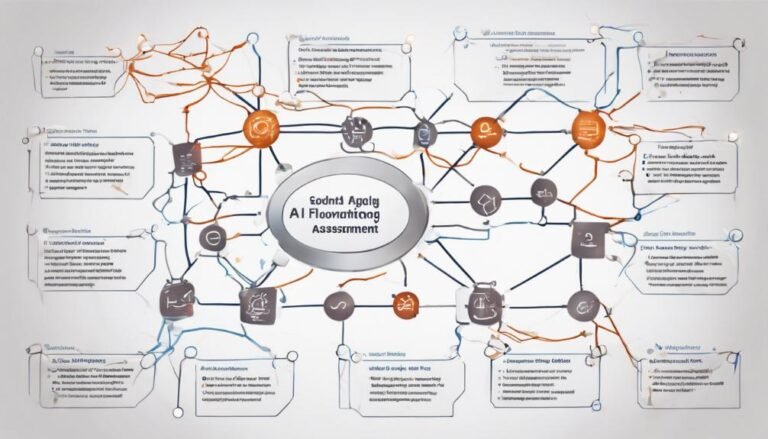AI in Fraud Risk Assessment
Did you know that AI can greatly enhance fraud risk assessment by swiftly analyzing complex data patterns to uncover potential fraud schemes? The integration of artificial intelligence in risk assessment processes has revolutionized the way organizations combat fraudulent activities. Discover the transformative capabilities of AI in identifying and mitigating fraud risks, and explore how these advanced technologies are reshaping the landscape of fraud prevention strategies.
Key Takeaways
- AI utilizes machine learning for pattern detection in fraud activities.
- Real-time data analysis enhances precision in risk identification.
- Automation streamlines risk assessment procedures for faster decisions.
- Predictive modeling assesses likelihood of fraud based on various factors.
- Continuous refinement of AI models adapts to evolving threats for improved risk management.
Role of AI in Fraud Detection
How does AI enhance fraud detection capabilities in risk assessment processes?
Machine learning applications and data analytics techniques play an essential role in bolstering fraud detection mechanisms. By utilizing machine learning algorithms, AI systems can analyze vast amounts of data to identify patterns and anomalies that may indicate fraudulent activities. These applications can adapt and improve over time, continuously enhancing their ability to detect new and sophisticated fraud schemes.
Data analytics techniques further strengthen fraud detection by providing insights into historical trends and behaviors. AI systems can leverage this information to create predictive models that assess the likelihood of fraud based on various factors. Through the use of advanced analytics, organizations can proactively identify potential risks and take preemptive action to mitigate fraudulent activities.
Benefits of AI in Risk Assessment
Utilizing AI in risk assessment processes offers organizations a range of benefits, including improved accuracy and efficiency in identifying potential threats. By harnessing AI algorithms, organizations can enhance the accuracy of risk assessments through the analysis of vast amounts of data in real-time. AI can quickly detect patterns and anomalies that might go unnoticed by traditional methods, thereby increasing the precision of risk identification.
Moreover, AI systems can streamline risk assessment procedures, leading to enhanced efficiency within organizations. Automation of repetitive tasks, such as data collection and analysis, allows for faster decision-making processes and minimizes the time required to assess potential risks.
This efficiency not only saves time but also reduces the likelihood of human errors that can occur during manual risk assessments.
AI Technologies for Fraud Prevention
AI technologies play a pivotal role in enhancing fraud prevention strategies by leveraging advanced algorithms and real-time data analysis. Machine learning, a subset of AI, is particularly effective in fraud prevention. It enables systems to learn from historical data, detect patterns, and predict potential fraudulent activities. By continuously analyzing vast amounts of data, machine learning algorithms can identify anomalies or suspicious behavior that may indicate fraud.
Data analysis is another essential component of AI technologies for fraud prevention. Through sophisticated data analysis techniques, AI systems can sift through massive datasets to uncover hidden patterns or discrepancies that human analysts may overlook. This analytical approach allows for the swift detection of fraudulent transactions or activities, minimizing financial losses and reputational damage for businesses.
Implementing AI in Risk Management
Implementing artificial intelligence (AI) in risk management enhances decision-making processes through advanced data analysis and predictive modeling techniques. Machine learning applications play a vital role in this integration, allowing for the identification of patterns and anomalies within data that might indicate potential risks. By utilizing data analytics, organizations can efficiently assess vast amounts of information to pinpoint areas of concern and prioritize risk mitigation strategies.
Predictive modeling, a pivotal component of AI in risk management, enables organizations to forecast potential risks based on historical data and ongoing trends. This proactive approach empowers businesses to implement preventive measures before fraudulent activities occur, ultimately reducing the impact of such incidents.
Through the continuous refinement of predictive models, organizations can adapt to evolving threats and enhance their overall risk management strategies.
Future Trends in AI for Fraud Risk
To stay ahead in fraud risk assessment, exploring emerging advancements in artificial intelligence (AI) is essential. Looking into the future trends of AI for fraud risk, two critical aspects to take into account are ethical implications and industry applications.
As AI systems become more sophisticated in detecting fraudulent activities, the ethical considerations surrounding data privacy, algorithm bias, and the potential misuse of AI tools must be carefully addressed. Transparency and accountability in AI decision-making processes are vital to guarantee fairness and trust in fraud risk assessment practices.
In terms of industry applications, AI is projected to revolutionize fraud risk assessment across various sectors such as banking, insurance, e-commerce, and healthcare. Advanced AI algorithms can analyze vast amounts of data in real-time, enabling organizations to proactively identify and mitigate fraud risks.
Moreover, the integration of AI with other technologies like blockchain and IoT devices will enhance fraud detection capabilities and strengthen overall security measures. Embracing these future trends in AI for fraud risk will be crucial for organizations to adapt to evolving threat landscapes and safeguard against financial losses.
Conclusion
To sum up, AI is revolutionizing fraud risk assessment by leveraging advanced algorithms to analyze data and detect anomalies with unprecedented accuracy.
The benefits of AI in risk management are vast, from enhancing efficiency to minimizing errors and strengthening fraud prevention strategies.
As AI technologies continue to evolve and adapt, the future of fraud prevention looks brighter than ever, with the potential to eradicate fraud completely, a feat once thought impossible.







